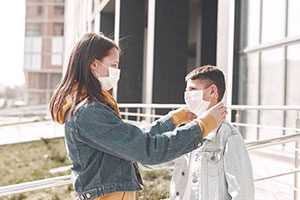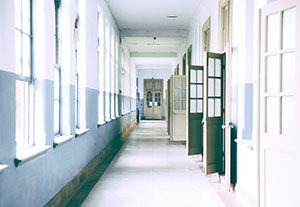
Teachers, administrators and civic leaders are currently hammering out a plan to get kids back in school this fall.
By Rachel Berets
Five weeks before the school year is set to begin, the Somerville Teachers Association (STA) and the district are debating the safest and most effective way to start teaching in September amidst the coronavirus pandemic.
At a Town Hall on Wednesday July 29, the Mayor of Somerville, Joe Curtatone, Superintendent Mary Skipper, and other administrators presented an update on the Somerville Public Schools Reopening Plan.
They are leaning toward a hybrid model – a half in-person, half remote system – even though 85 percent of the Somerville Teachers Association supports a phased-in approach, starting school in the fall completely remote and moving into a hybrid system when community health numbers and building safety allow it.
“None of these choices are good choices,” said Rami Bridge, President of the Somerville Teachers Association and a teacher at the West Somerville Neighborhood School. “But we can’t enable this reopening to push forward if it’s not healthy and safe.”
In June, the Massachusetts Department of Elementary and Secondary Education (DESE) asked all the state’s school districts to create three plans: a fully in-person plan, a hybrid plan with both remote and in-person elements, and a fully remote plan.
 The district must turn in complete plans for the three different scenarios to the state by August 10, but they have already ruled out a fully in-person option.
The district must turn in complete plans for the three different scenarios to the state by August 10, but they have already ruled out a fully in-person option.
“DESE asked all the districts not to be explicit about what they are doing until August 10,” said Carrie Normand, the Chair of the Somerville School Committee. “But I believe strongly that the more transparent we can be, especially when there’s so many uncertainties, the better.”
Both the STA and the district have expressed frustration about the lack of guidance from the state. “To say something like ‘make schools safer’ without more specificity is challenging at best and I think every district is struggling with it,” said Normand.
At the Town Hall Superintendent Skipper laid out Somerville’s reopening guidelines that go beyond those of the state. The safety measures for the hybrid model include six-feet of social distancing space, required face coverings for all students and staff, health screenings, and limited material sharing.
The district is also exploring unconventional use of outdoor space and attempting to equip all students with devices and internet access.
One of the main concerns for the district and the STA is the condition of the building’s ventilation systems. There is some evidence that coronavirus can linger in the air and poor ventilation could exacerbate the spread of the virus.
The state has not put in place any specific air standards, but the district has been conducting ventilation assessments to determine if the air flow in classrooms and bathrooms is adequate or if the buildings need to be outfitted with filters, box fans, or air purifiers.
Bridge expressed skepticism that the district will be able to evaluate air flow and make the necessary infrastructure changes by the start of the school year.
“We have many classrooms that don’t have windows in them, we have many classrooms that have windows that don’t open,” said Bridge. “School is supposed to start in five weeks. It’s just unrealistic that all the changes are going to get done in the timeframe that we need to get them done in.”
Bridge would like the district to announce their plan as soon as possible so that teachers and students will have more time to prepare for remote learning.
“Our position is that the sooner we decide we are beginning remote, the sooner we can work to make remote learning better. It doesn’t mean we are going to be remote all year, it means we can continue building capacity in the buildings and looking at what a hybrid model could look like,” said Bridge.
But even as teachers work to improve remote learning, research suggests that remote learning is not always effective and can lead to achievement gaps.
The district is particularly concerned with what it sees as its more “vulnerable student populations” – English Language Learners, special education students, low-income students and pre-kindergarten through third grade students.
There are concerns that parents working outside the home will not be able to help with technology, that children will not have access to mental health services including counselors and therapists, and that young students are not able to engage with remote learning resulting in learning loss.
“Remote learning will not solve all of their problems, no matter how rugged or how good the remote learning is,” said Superintendent Skipper. “For our most vulnerable students, we need to find a way to get some in-person instruction for them.”
Any hybrid model that the district chooses would mostly likely prioritize in-person learning for the most vulnerable populations.
Bridge acknowledges that remote learning leaves many gaps, but also points out that life in the classroom in September will not look at all like it did in February – desks will be spread apart, there will be no papers to pass around. “The question is,” he said, “does it add enough value to make it worth the risk?”
Update as of August 4, 2020
Somerville will start this school year with fully remote learning. The school system will seek to move toward a hybrid model with an eventual return to full-time in-person education as that becomes practical during this pandemic. The following is the letter sent to all SPS families explaining this decision.
Dear Somerville Public Schools Families,
After much discussion and review of preliminary data from our building assessment, we made the decision this morning to begin the 2020-2021 school year with full remote learning in the initial phase of reopening model. Over the last several months, we have been working diligently to put all the pieces in place to support a safe return to in-person instruction in a phased hybrid model. That planning has included bringing in an engineering firm to assess the ventilation and filtration systems in our school buildings, and working to set up a virus surveillance testing plan for students and staff. As we have said from the beginning, the safety and health of our students, staff, and families is and will remain our top priority. We do not believe that opening school for in-person instruction without these two important safety components of the school reopening plan in place and resolved is safe or in the best interest of our school community.
We appreciate all of the thoughts, feelings, and feedback our staff and families have provided over the past several weeks. One thing is clear: Everyone is in agreement that in-person instruction is the best thing for students and educators miss their students and students miss their teachers, paras and counselors. We are doing everything we can to be ready for an eventual return to phased in-person instruction under the new safety guidelines. At day’s end, we need to ensure that we have done everything possible to mitigate the risks of a return to our schools – so that our staff, students, and families feel safe and are safe. As a community, our approach in Somerville has been guided by a firm commitment to health and safety first, recognizing that we are dealing with a very complex and continuously evolving health crisis.
We are actively exploring options including outdoor solutions as a way that staff, students, and families can meet in person. We are also actively working with our partners who provide youth services in the hope that we can develop a menu of activities outdoors to help support the social emotional needs of students for the remote learning time. In the coming weeks, we will continue to address the ventilation and filtration issues to allow for a safe return to our school buildings, and work with our health partners to create a testing system that will further ensure the safety of our students and staff. We will also continue to work with our unions collaboratively around how to have a successful reopening with a more robust remote learning experience for all and identify the timeline and conditions for an in-person return, especially for our ELL, Special Education, and Prek-2 students who struggle the most in a remote model.
Over the next few weeks, as we continue to develop, negotiate, and finalize our remote learning and hybrid plans, we will send regular updates including the new academic calendar and opportunities for outdoor activities for our students during remote learning. We appreciate your partnership and continued patience and understanding as we do our best to work through this unprecedented challenge.
Respectfully,
Mayor Joe Curtatone, Superintendent Mary Skipper, School Committee Chair Carrie Normand












Reader Comments